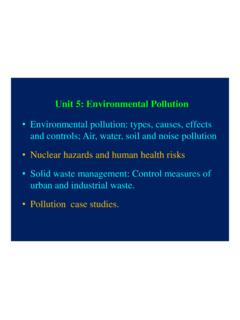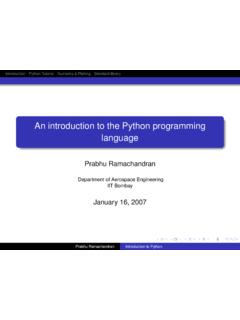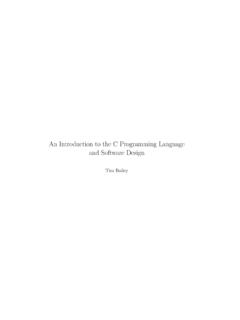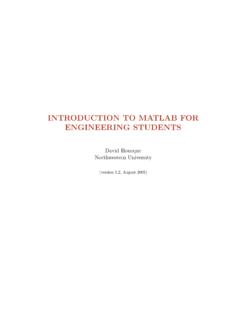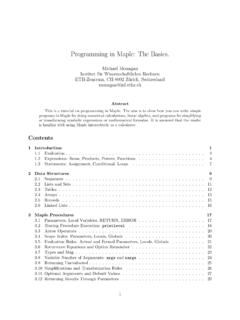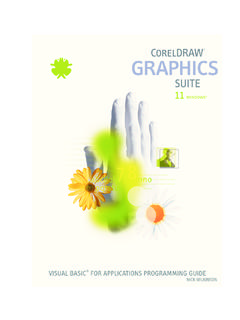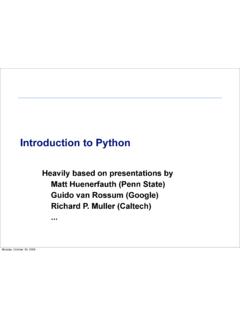Transcription of INTRODUCTION TO PROBLEM SOLVING USING C
1 1 J. JAGADEESAN, ASST. PROFESSOR OF COMPUTER SCIENCE, AAGASC, KARAIKAL-609 605. INTRODUCTION TO PROBLEM SOLVING USING C Module I INTRODUCTION to Computers - Characteristics of Computers, Uses of computers, Types and generations of Computers Basic Computer Organization -Modules of a computer Planning the Computer Program - Debugging, Types of errors - Documentation Techniques of PROBLEM SOLVING PROBLEM SOLVING aspects Top- Down aspects Implementation of algorithms Program verification - Flowcharting, decision table, algorithms, Structured programming concepts, programming methodologies viz. top-down and bottom-up programming . Basic Concepts of Computer Computer is an electronic device which is used to store the data, as per given instructions it gives results quickly and accurately.
2 Data : Data is a raw material of information. Information : Proper collection of the data is called information. Characteristics of Computer 1. Speed: - As you know computer can work very fast. It takes only few seconds for calculations that we take hours to complete. You will be surprised to know that computer can perform millions (1,000,000) of instructions and even more per second. Therefore, we determine the speed of computer in terms of microsecond. 2. Accuracy: - The degree of accuracy of computer is very high and every calculation is performed with the same accuracy. The accuracy level is 7. determined on the basis of design of computer. The errors in computer are due to human and inaccurate data. 3. Diligence: - A computer is free from tiredness, lack of concentration, fatigue, etc. It can work for hours without creating any error.
3 If millions of calculations are to be performed, a computer will perform every calculation with the same accuracy. Due to this capability it overpowers human being in routine type of work. 4. Versatility: - It means the capacity to perform completely different type of work. You may use your computer to prepare payroll slips. Next moment you may use it for inventory management or to prepare electric bills. 5. Power of Remembering: - Computer has the power of storing any amount of information or data. Any information can be stored and recalled as long as you require it, for any numbers of years. It depends entirely upon you how much data you want to store in a computer and when to lose or retrieve these data. 6. No IQ: - Computer is a dumb machine and it cannot do any work without instruction from the user.
4 It performs the instructions at tremendous speed and with accuracy. It is you to decide what you want to do and in what sequence. So a computer cannot take its own decision as you can. 7. Storage: - The Computer has an in-built memory where it can store a large amount of data. You can also store data in secondary storage devices such as floppies, which can be kept outside your computer and can be carried to other computers. 2 J. JAGADEESAN, ASST. PROFESSOR OF COMPUTER SCIENCE, AAGASC, KARAIKAL-609 605. Uses of Computers Education : Getting the right kind of information is a major challenge as is getting information to make sense. College students spend an average of 5-6 hours a week on the internet. Research shows that computers can significantly enhance performance in learning. This offers a variety of internet and video-based online courses.
5 Health and Medicine : Computer technology is radically changing the tools of medicine. All medical information can now be digitized. Software is now able to computer the risk of a disease. Mental health researchers are USING computers to screen troubled teenagers in need of psychotherapy. A patient paralyzed by a stroke has received an implant that allows communication between his brain and a computer; as a result, he can move a cursor across a screen by brainpower and convey simple messages. Science : Scientists have long been users of it. A new adventure among scientists is the idea of a collaboratory , an internet based collaborative laboratory, in which researchers all over the world can work easily together even at a distance. An example is space physics where space physicists are allowed to band together to measure the earth s ionosphere from instruments on four parts of the world.
6 Business : Business clearly see the interest as a way to enhance productivity and competitiveness. Some areas of business that are undergoing rapid changes are sales and marketing, retailing, banking, stock trading, etc. Sales representatives not only need to be better educated and more knowledgeable about their customer s businesses, but also must be comfortable with computer technology. The internet has become a popular marketing tool. The world of cybercash has come to banking not only smart cards but internet banking, electronic deposit, bill paying, online stock and bond trading, etc. Government: Various departments of the Government use computer for their planning, control and law enforcement activities. To name a few Traffic, Tourism, Information & Broadcasting, Education, Aviation and many others.
7 Defence: There are many uses computers in Defence such as: Controlling UAV or unmanned air-crafts an example is Predator. If you have cable I would recommend watching the shows Future Weapons" and Modern Marvels". The show future weapon gives an entire hour to the predator. They are also used on Intercontinental Ballistic Missiles (ICBMs) that uses GPS and Computers to help the missile get to the target. Computers are used to track incoming missiles and help slew weapons systems onto the incoming target to destroy them. Sports: In today's technologically growing society, computers are being used in nearly every activity. Recording Information : Official statistics keepers and some scouts use computers to record statistics, take notes and chat online while attending and working at a sports event.
8 Analyzing Movements : The best athletes pay close attention to detail. Computers can slow recorded video and allow people to study their specific movements to try to improve their tendencies and repair poor habits. 3 J. JAGADEESAN, ASST. PROFESSOR OF COMPUTER SCIENCE, AAGASC, KARAIKAL-609 605. TYPES OF COMPUTERS or Classification of Computers 1. Super Computers 2. Main Frame Computers 3. Mini Computers 4. Micro Computers 1. Super Computers are the most powerful computers in terms of speed of execution and large storage capacity. NASA uses supercomputers to track and control space explorations. :- CRAY Research :- CRAY-1 & CRAY-2, Fujitsu (VP2000), Hitachi (S820), NEC (SX20), PARAM 10000 by C-DAC, Anupam by BARC, PACE Series by DRDO Most powerful Computer system - needs a large room Minimum world length is 64 bits CPU speed: 100 MIPS Equivalent to 4000 computers High cost: 4 5 millions Able to handle large amount of data High power consumption High precision Applications In petroleum industry - to analyze volumes of seismic data which are gathered during oil seeking explorations to identify areas where there is possibility of getting petroleum products inside the earth In Aerospace industry - to simulate airflow around an aircraft at different speeds and altitude.
9 This helps in producing an effective aerodynamic design for superior performance In Automobile industry to do crash simulation of the design of an automobile before it is released for manufacturing for better automobile design 2. Mainframe Computers Are next to supercomputers in terms of capacity. The mainframe computers are multi terminal computers, which can be shared simultaneously by multiple users. Unlike personal computers, mainframe computers offer time-sharing For example, insurance companies use mainframe computers to process information about millions of its policyholders. :- IBM 3000 series, Burroughs B7900, Univac 1180, DEC Able to process large amount of data at very high speed Supports multi-user facility Number of processors varies from one to six. Cost: 3500 to many million dollars Kept in air conditioned room to keep them cool Supports many I/O and auxiliary storage devices Supports network of terminals 4 J.
10 JAGADEESAN, ASST. PROFESSOR OF COMPUTER SCIENCE, AAGASC, KARAIKAL-609 605. Applications Used to process large amount of data at very high speed such as in the case of Banks/ Insurance Companies/ Hospitals/ need online processing of large number of transactions and requires massive data storage and processing capabilities Used as controlling nodes in WANs (Wide Area Networks) Used to mange large centralized databases 3. Minicomputers These computers are also known as midrange computers. These are desk-sized machines and are used in medium scale applications. For example, production departments use minicomputers to monitor various manufacturing processes and assembly-line operations. :- Digital Equipments PDP 11/45 and VAX 11) Perform better than micros Large in size and costlier than micros Designed to support more than one user at a time Posses large storage capacities and operates at higher speed Support faster peripheral devices like high speed printers Applications These computers are used when the volume of processing is large for Data processing for a medium sized organization Used to control and monitor production processes To analyze results of experiments in laboratories Used as servers in LANs (Local Area Networks) 4.
